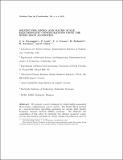| dc.contributor.author | Lazic, Predrag | |
| dc.contributor.author | Corona, T. J. | |
| dc.contributor.author | Stefancic, Hrvoje | |
| dc.contributor.author | Abraham, Hrvoje | |
| dc.contributor.author | Gluck, Ferenc | |
| dc.contributor.author | Formaggio, Joseph A | |
| dc.date.accessioned | 2013-11-26T20:33:45Z | |
| dc.date.available | 2013-11-26T20:33:45Z | |
| dc.date.issued | 2012 | |
| dc.date.submitted | 2011-11 | |
| dc.identifier.issn | 1937-6472 | |
| dc.identifier.uri | http://hdl.handle.net/1721.1/82600 | |
| dc.description.abstract | We present a novel technique by which highly-segmented electrostatic configurations can be solved. The Robin Hood method is a matrix-inversion algorithm optimized for solving high density boundary element method (BEM) problems. We illustrate the capabilities of this solver by studying two distinct geometry scales: (a) the electrostatic potential of a large volume beta-detector and (b) the field enhancement present at surface of electrode nano-structures. Geometries with elements numbering in the O(105) are easily modeled and solved without loss of accuracy. The technique has recently been expanded so as to include dielectrics and magnetic materials. | en_US |
| dc.description.sponsorship | United States. Dept. of Energy (Grant No. DE-FG02-06ER-41420) | en_US |
| dc.description.sponsorship | Germany. Federal Ministry of Education and Research ((BMBF) under contract Nr. 05CK5VKA/5) | en_US |
| dc.language.iso | en_US | |
| dc.publisher | Electromagnetics Academy (EMW Publishing) | en_US |
| dc.relation.isversionof | http://dx.doi.org/10.2528/PIERB11112106 | en_US |
| dc.rights | Creative Commons Attribution-Noncommercial-Share Alike 3.0 | en_US |
| dc.rights.uri | http://creativecommons.org/licenses/by-nc-sa/3.0/ | en_US |
| dc.source | Prof. Formaggio via Chris Sherratt | en_US |
| dc.title | SOLVING FOR MICRO- AND MACRO-SCALE ELECTROSTATIC CONFIGURATIONS USING THE ROBIN HOOD ALGORITHM | en_US |
| dc.type | Article | en_US |
| dc.identifier.citation | Formaggio, Joseph A., Predrag Lazic, T. J. Corona, Hrvoje Stefancic, Hrvoje Abraham, and Ferenc Gluck. "Solving for Micro- and Macro-scale Electrostatic Configurations Using the Robin Hood Algorithm." Progress In Electromagnetics Research B 39 (2012): 1-37. | en_US |
| dc.contributor.department | Massachusetts Institute of Technology. Department of Materials Science and Engineering | en_US |
| dc.contributor.department | Massachusetts Institute of Technology. Department of Physics | en_US |
| dc.contributor.department | Massachusetts Institute of Technology. Laboratory for Nuclear Science | en_US |
| dc.contributor.approver | Formaggio, Joseph A. | en_US |
| dc.contributor.mitauthor | Formaggio, Joseph A. | en_US |
| dc.contributor.mitauthor | Lazic, Predrag | en_US |
| dc.relation.journal | Progress In Electromagnetics Research B | en_US |
| dc.eprint.version | Author's final manuscript | en_US |
| dc.type.uri | http://purl.org/eprint/type/JournalArticle | en_US |
| eprint.status | http://purl.org/eprint/status/PeerReviewed | en_US |
| dspace.orderedauthors | Formaggio, Joseph A.; Lazic, Predrag; Corona, T. J.; Stefancic, Hrvoje; Abraham, Hrvoje; Gluck, Ferenc | en_US |
| dc.identifier.orcid | https://orcid.org/0000-0002-3757-9883 | |
| mit.license | OPEN_ACCESS_POLICY | en_US |
| mit.metadata.status | Complete | |
